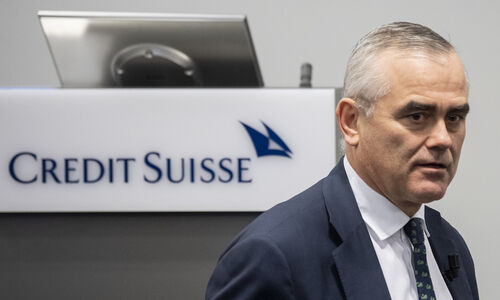Questions Over Credit Suisse Capital Strength
The Swiss bank's ebbing capital cushion has analysts asking whether it will be able to make good on the second leg of a dividend for last year.
Credit Suisse is on thin ice; if the pandemic-induced economic crisis worsens, its capital reserves won't provide much more protection – and the Swiss lender ranks among the weakest equipped banks in Europe in capital terms in a so-called stress scenario.
That is the short version of a 19-page study issued recently by brokerage Kepler Chevreux. Analysts have taken a closer look at the bank's capital after Credit Suisse said in its first-quarter report it expected its Tier 1 ratio – its toughest type of capital – to sink to 11.5 percent by year-end, from 12.7 percent at the end of 2019.
Credit Suisse Shares Lag
The bank cited regulatory changes from the Bank for International Settlements dubbed Basel III as well as an expected rise in risk-weighted assets due to far more volatile financial markets. UBS also expects its capital to edge lower, with similar reasoning.
But the focus is squarely on Credit Suisse, with investors sending the stock more than 24 percent lower so far this year – dramatically worse than UBS, which has shed ten percent. Credit Suisse's book value per share is at a historic low of 0.5 percent.
Surging Spreads
Investor misgivings about Credit Suisse first emerged in February as the corona-related market rout was brewing. Spreads on the Swiss bank's credit default swaps, or CDSs, surged to 147 basis points from 44 – putting it on a level of less stable European banks. By contrast, the spread on UBS' CDS peaked at 64.
Credit Suisse also bumped the Swiss regulator's guardrails repeatedly shortly after Covid-19 was declared a pandemic, as finews.com reported in May. The move would normally trigger an additional capital requirement, but Switzerland's Finma waived the rule in view of the crisis. Shortly afterward, the regulator adopted the waiver into its permanent policy.
Swiss Patron Saints
In March and April, companies scrambled to draw down liquidity from their credit lines with lenders – and in turn, banks like Credit Suisse pulled out all the stops to maintain their liquidity. During this hectic period, Credit Suisse stood out in the structured products market for instruments with the highest coupons, according to market observers – and the bank also offered fixed-term deposit accounts at rates well above LIBOR.
In March, Switzerland's central bank leaped to the aid of banks and dispensed of a so-called anti-cyclical buffer, which is effectively a maximum 2.5 percent additional capital requirement against property lending risk. In short, Credit Suisse's capital requirements were eased in an economic environment in which a bigger cushion is advisable.
Corporate Bond Risk
The Swiss National Bank, SNB, and Finma acted as a kind of patron saint of Swiss banking in March and April. Specifically, the SNB lauded Credit Suisse for its solid capital base as well as for both major banks' padding reserves against future credit defaults (1 billion francs at Credit Suisse).
The favorable view of Credit Suisse's capital strength contrasts with a more nuanced, critical one by analysts. Kepler Chevreux noted that Credit Suisse is at a high risk of corporate bonds defaulting in view of its own capital cushion. Barclays in April wrote that its reserves for market adjustments may not be adequate – meaning future write-downs could eat directly into Credit Suisse's capital.
Revenue Tumble Expected
The biggest risk for Credit Suisse led since February by long-standing investment banker Thomas Gottstein is the uncertainty around how big of a bite the coronavirus crisis will chomp out of revenue and profits. The lender was (understandably) vague in its first-quarter report. Credit Suisse didn't revise forecasts in a recent investor conference – which can be taken as a favorable sign.
But the pandemic will wreak havoc on Credit Suisse's second-quarter, as well as in revenue further out. A reported revamp is likely to focus mainly on more spending cuts – the bank is due to say more on June 30 during its quarterly report.
A projected double-digit drop in revenue poses a major problem for Credit Suisse, in that the bank will be hamstrung to bolster its capital. This in turn raises questions over its dividend, the second leg of which is due later this year following an April regulatory reprimand for the wider finance industry.
Shareholder Appeasement
Credit Suisse told investors at June's conference that it intends to pay the second tranche of its dividend from 2019, would consider resuming share buybacks, and is stowing cash for shareholder payouts for this year and next.
The remarks by CFO David Mathers translate to appeasing shareholders after Credit Suisse only relatively recently shifted to a friendlier policy for its investors. It pledged to keep hiking its dividend provided it meets capital goals and switched to cash payouts.
No Payouts Before 2021?
The bank's share price implies that investors aren't buying it; analysts from both Zuercher Kantonalbank as well as J.P. Morgan don't believe Credit Suisse will make the second dividend payment. The U.S. house said payouts for shareholders were unlikely until 2021.
London-based analyst Kian Abouhossein identified the potential for conflict with some shareholders who had advocated for ex-CEO Tidjane Thiam to stay (he was ousted in February). The wounds could reopen, Abouhossein noted – a further risk for Credit Suisse.
Late Response
The bank eschewed a response to capital and dividend questions before publication. On Monday following the publication of this article, a spokesman said «Credit Suisse is very well-capitalized».
All capital metrics exceed regulatory requirements, with a common equity Tier 1 ratio of 12.1 percent compared to a ten percent requirement and a Tier 1 leverage ratio of 5.8 percent compared to a requirement of five percent. Credit Suisse possesses the largest loss-absorbing capital of any bank in Switzerland, with common equity Tier a capital of 36.3 billion and total loss-absorbing capital of 92.9 billion.»




























